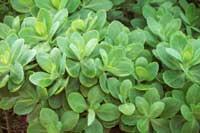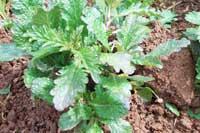Medicinal plants: Rich pharmacy of nature
The same happens with the remedies and, in addition to official medicine, other types of medicine are sought, including the use of medicinal plants to cure diseases.

In Euskal Herria they have always been used and, fortunately, there are still people who separate the herbs and who know well their characteristics, uses and effects.
It is undeniable that some plants contain components that help cure certain diseases and, in many cases, drugs in the pharmaceutical industry contain active components extracted from the plants. In fact, half of the pharmaceutical products currently used come from natural sources. Perhaps the best known example is aspirin, a component originally present in the skin and willow leaves. Before the commercialization of aspirin by the pharmaceutical industry Bayer, to relieve pain and reduce fever, these parts of the willow were cooked and taken as herbaceous water in different places. Another example is the quinine obtained from the kina tree, which is still used in many countries against malaria. Now, in the fight against diseases as serious as AIDS, Alzheimer's and cancer, researchers from all over the world have resorted to natural sources, since the solution can be in plants or animals.

However, for some physicians, plant medicines are very dangerous and favor pharmaceutical products. According to these physicians, the concentrations of the components of pharmaceutical products are well measured, which allows to know precisely the amount given to the patient. On the other hand, most medicinal plants have identified only the active component. Therefore, among unknown components, some may have adverse effects on the active component and, therefore, prevent the healing process or produce adverse side effects. Besides, it is common to hear that natural subjects do not cause damage. However, there are many toxic and deadly plants that break it down.
Despite all this, in traditional medicine, the priority of medicinal plants is evident. Thus, in the 1970s, coinciding with the beginning of social questioning and life in developed countries, they began to look at other cultures and to think that their wealth could be beneficial. World organizations also became aware for thousands of years of the importance of knowledge acquired through experience and paid attention to traditional medicine until then forgotten or excluded. For example, the World Health Organization (WHO), since recommending the use of traditional remedies in the 1978 Alma-Ata declaration, has published eleven reports, studies and resolutions confirming the value of medicinal plants.
According to the WHO definition, traditional medicine is a way to care for health and cure diseases before current medicine. It includes, therefore, the remedies developed for centuries to respond to the needs of each social group, that is, acupuncture, traditional aids to childbirth, the work of mental doctors and medical medicine. Thus, he created a special secretariat for the study of traditional medicine and, in 1991, Congress 44 adopted a resolution to promote the use of traditional "safe, effective and scientifically useful" treatments.

The importance of local customs and beliefs in health care is fundamental, even in developed countries. According to the data collected by the WHO, 60% of the drugs administered in China are medicinal plants, while in Japan medicines with medicinal plants are more than pharmaceutical products. In the United States, on the contrary, the medicinal plants that Indians have known forever, are now on sale in the form of pills or drinks, pharmacies and conventional stores.
In Africa, in addition to the widespread use of medicinal plants, they are also concentrated sporadically. The resulting active ingredients are used in Europe and North America against various diseases. In Central and South America the same occurs, that is, the plants used for thousands of years have spread to the whole world.
The WHO, for its part, prefers the use of traditional medicine in developing countries, since it is cheaper, more affordable and, in this case, more effective than the administration of drugs produced by the pharmaceutical industry.
UNESCO also shows a similar position and, for example, in the regulations on health of 1996, mentions medicinal plants and warns of the need to protect them for their importance in health care in many cultures. It is necessary to preserve the vegetable remedies to respect and protect the local culture. However, UNESCO also considers the risk posed by pharmaceutical industries. In fact, by extracting from the plants some of the active components necessary for the elaboration of the pharmaceutical products and by their collection system, in some cases they are in the process of extinction or have diminished the genetic diversity of them. The pharmacy of nature is not inexhaustible.
Medicinal plants of Marai
In Euskal Herria medicinal plants have always been used and so that this wealth does not disappear, there are also people who write what they know and spread it on the internet, like the sisters Maria Jesus and Pepita of the Marai hamlet of Oiartzun.
They say that almost everything they know they have received from their parents and from the people around them, although they also consider it necessary to experience well the characteristics of the herbs.
Two sisters say that "the people around us know us well. Some come in search of a specific herb and others in search of the treatment they must perform to cure their disease." The influence of medicinal plants is not scientifically demonstrated, but these remedies have allowed many people to recover. The people around them know them and know that nothing they have given them is going to hurt them, so they trust.
What to cure?

Mainly infections, wounds, high stress, excessive cholesterol, diabetes, worms, liver diseases, kidney, cataract, inflammations, pain, etc. They are used to cure the herbs of their meadows. They cure almost everything, but they know perfectly that in some cases it is necessary to go to the doctor, for example, in cases where surgery is necessary.
However, they consider that official medicine and medicinal plants are not comparable. "What is achieved with some herbs, the doctor can't do it, and vice versa, there are diseases that can't be cured with herbs. Therefore, they are complementary. Doctors cut the disease with a blow, but the best way to restore the body are the medicinal plants. Its effect is slower, though slower, than other drugs, but they completely complete the body." In addition, the two sisters have explained that although to cure some diseases it is necessary to follow medical treatment, it is convenient to take herbs to complete the body. After all, herbaceous water has something good: if taken properly, it does not harm and can be taken along with the medicines provided by the doctor.
In any case, they say it is very important to believe that treatment will benefit from yourself, whether medical or pharmaceutical. If not believed, it will have less effect and although the treatment is adequate, it is not cured. No one should take any
Only well-known herbs will be used. Know perfectly the influence of each herb and its possible problems. Two sisters advise to be careful: "We must never forget that excessive ingestion of medicinal plants can cause death." Therefore, it is very important to respect the number of days to be taken and the rest intervals to be kept.
It is not enough to know the medicinal plants, since before preparing the herbs and the plants it is necessary to know how to dry the grass well. For this it is necessary to collect the herbs that surround the house and dry them in dark, in dry place and in weather conditions.
Published in the supplement Natura de Gara.
Buletina
Bidali zure helbide elektronikoa eta jaso asteroko buletina zure sarrera-ontzian











